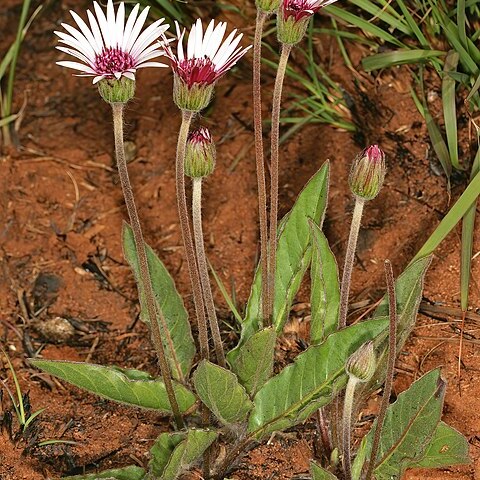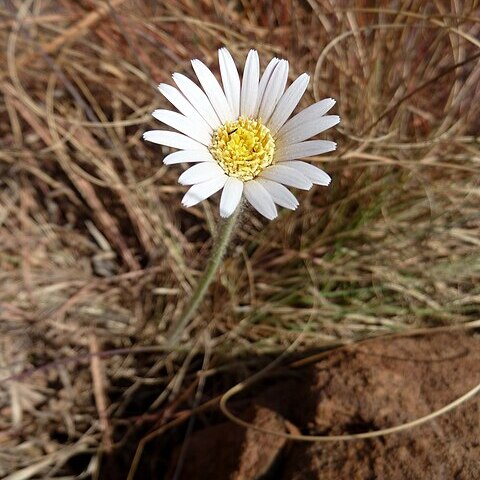Herb with woody rootstock and fleshy roots; crown of rootstock densely woolly with long white hairs.. Leaves petiolate, densely white-cottony when young; petiole often tinged purple or magenta, 1–25 cm long; blade obovate, elliptic or ovate, 2–20 cm long, 1–10 cm wide, base rounded, broadly cuneate, truncate or cordate, margins sinuate or sinuate-denticulate or rarely ± entire, apex obtuse and apiculate or rarely shortly acuminate, pale green, finely puberulous and ± glabrescent, sometimes cottony-floccose or rarely shortly pilose beneath, bright green, subglabrous or minutely punctate or rarely shortly pilose above, fringed with short hairs and sometimes darkened at the margins.. Scapes 1–3 from each rosette, sometimes precocious, green, 10–75 cm tall, pubescent with rather sparse to dense ± spreading cottony hairs, denser, more appressed and often brownish in upper part, not inflated below the capitulum, ebracteate; capitula with the rays ± twice as long as the involucre, ± 2.5 cm in diameter; involucre cylindrical or shortly so, thinly to densely cottony with long hairs at the base, 8–17 mm long, becoming broader, slightly longer (12–18 mm) and nodding in fruit; phyllaries 20–50, lanceolate, green or variously tinged purple or brownish, the longest 10–15.5 mm long, acute, subglabrous to densely tomentose.. Outer florets 20–35, female; corolla 14–23 mm long, with the outer lip ray-like, white or pinkish above, pink to deep maroon beneath, 10–19 mm long, 1.8–2.7 mm wide; outermost inner florets ± 15–30, female, innermost 30–120, hermaphrodite; corollas with subequal lips, white or cream, 5–9 mm long.. Achenes fusiform, brown, 7–9 mm long, 10-ribbed, beaked, shortly pilose; pappus of stramineous shortly barbellate bristles, 5–8 mm long.. Fig. 3/1–4.
Perennial herb, acaulescent; crown ± silky pilose-villose. Leaves in basal rosette, sessile or distinctly petiolate; blade narrowly obovate, elliptic, oblong or rarely ovate, base cuneate, sometimes cordate, margins entire or with remote crenate, distinct teeth, ciliate; young leaves and scapes moderately pilose-villose with whitish hairs; glabrescent to glabrous at maturity. Heads radiate, solitary, on long peduncles (scapes). Scapes up to 200 mm high, not swollen below head; contemporary with leaves. Flowers: ray florets biseriate, prominent, white above, pink, red, mauve, crimson below or even yellow; disc florets white, yellow or tinged greenish; Sep.-Feb. Fruit with cypsela pubescent-pilose, with beak 2-5 mm long. Pappus of many barbellate bristles, whitish, sometimes violet-purple.
Outer florets female, of two kinds; a marginal series of ray-florets with the outer lip erect c.(8) 15(24) x 1.7 mm., oblong-elliptic, minutely 3-dentate, usually white inside and reddish or purplish on the margins and outside (in the Flora Zambesiaca area), the inner lip of 2 c. 2 mm. long linear often curled lobes, the tube c. 4(6) mm. long cylindric, pappus copius several-seriate of minutely barbellate setae 6–8 mm. long, achenes c. 6 mm. long and narrowly flask-shaped ± beaked when mature, 6–10-ribbed, minutely hispid; a submarginal series of bilabiate florets more numerous than the outer, corollas to c. 7 mm. long slender-tubular, the outer lip 2–3 mm. long and minutely 3-dentate, the inner lip of 2 erect linear lobes, the pappus and achenes as for the outer florets.
Leaves radical, ascending or spreading, very variable, usually petiolate; petiole up to c. 20 cm. long but usually shorter; lamina up to c. 22(28) x 14 cm., but usually smaller, elliptic or oblong, rounded mucronate at the apex, rounded or more usually cordate below and sometimes shortly decurrent on the petiole, sinuate-denticulate undulate or coarsely crenate-denticulate on the margins, upper surface at first pilose-hispid or sometimes sparsely long-pilose, usually glabrescent, lower surface thinly crisped pubescent to glabrescent sometimes with weak pilose hairs, the indumentum occasionally intermixed with glandular-capitate hairs.
Perennial herb, up to 0.2 m high; from thickened woody rootstock, root crowns densely silky-lanate. Leaves radical, ascending or spreading, petiolate, elliptic or oblong, rounded or cordate below and sometimes shortly decurrent on petiole, apex rounded mucronate, margins sinuate-denticulate, undulate or coarsely crenate-denticulate. Capitula solitary erect; involucres broadly obconic; bracts narrowly lanceolate to narrowly elliptic; scapes 1-several, erect slender. Ray florets usually white inside and reddish or purplish on the margins and outside. Disc florets bilabiate, functionally male, whitish. Flowering time Nov.-Feb.
Central florets numerous, bilabiate, functionally male, corollas whitish, 8–9 mm. long, the limb narrowly cylindric tapering below, 2-lipped above, the outer lip broadly elliptic and minutely 3-dentate, the inner lip with 2 linear curved lobes; achenes to c. 6 mm. long, somewhat flattened not swelling, minutely pubescent, pappus as for outer florets.
Scapes one-several, often appearing before the leaves, erect slender, up to c. 45 cm. long, densely brown-tomentose or white-lanate towards the apex, glabrescent to the base; indumentum of short crisped hairs intermixed with scattered long pilose hairs, occasionally also with few-numerous glandular-capitate hairs.
Capitula solitary erect; involucres mostly 10–18 x 20–30 mm., broadly obconic; phyllaries from c. 4 mm. long outside increasing to c. 20 mm. long inside, narrowly lanceolate to narrowly elliptic, lanate-pilose to crisped-pubescent or glabrescent, often also ± densely glandular-capitate.
An acaulescent perennial herb, from a thickened woody rootstock; rootcrowns densely silky-lanate; roots numerous brown thong-like, c. 2 mm. in diam.


